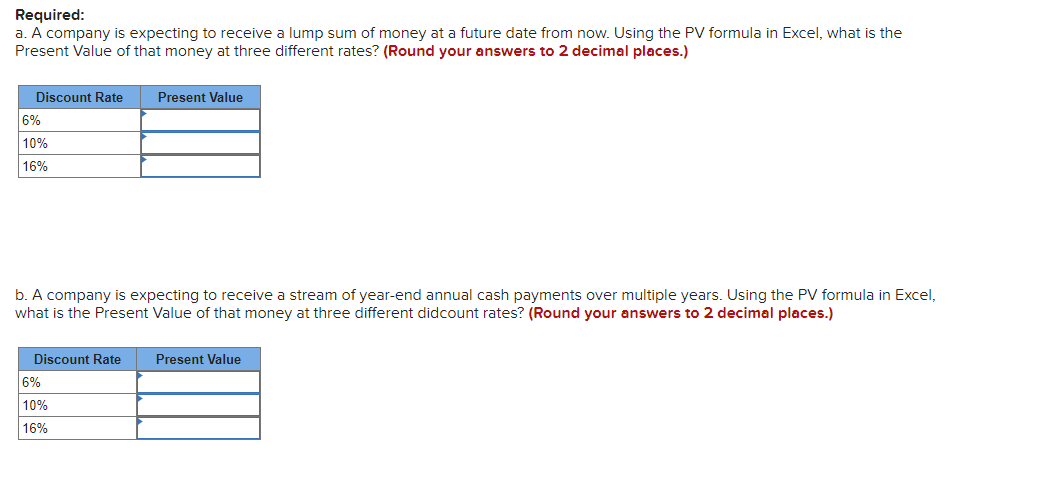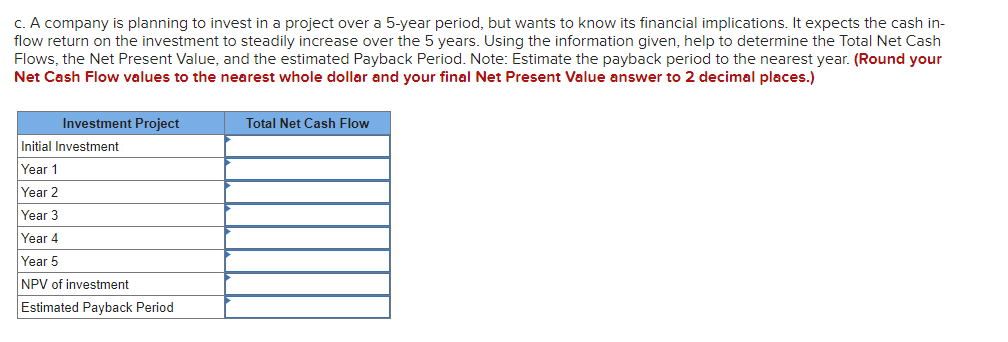For each requirement, change the values of the given information as shown and keep all other original data the same. Then enter your updated final answers for each scenario. Scenario A: Future value to be received $ 10,000 Future date received 3 years Discount Rate 6% 10% 16% Scenario B: Annual Cash Receipt $ 5,000 Number of Years 6 years Discount Rate 6% 10% 16% Scenario C: Discount Rate 8% Investment Project Cash Flow Initial Investment $ (6,500) Year 1 $ 700 Year 2 $ 800 Year 3 $ 1,400 Year 4 $ 3,600 Year 5 $ 6,800 Required: a. A company is expecting to receive a lump sum of money at a future date from now. Using the PV formula in Excel, what is the Present Value of that money at three different rates? (Round your answers to 2 decimal places.)
For each requirement, change the values of the given information as shown and keep all other original data the same. Then enter your updated final answers for each scenario. Scenario A: Future value to be received $ 10,000 Future date received 3 years Discount Rate 6% 10% 16% Scenario B: Annual Cash Receipt $ 5,000 Number of Years 6 years Discount Rate 6% 10% 16% Scenario C: Discount Rate 8% Investment Project Cash Flow Initial Investment $ (6,500) Year 1 $ 700 Year 2 $ 800 Year 3 $ 1,400 Year 4 $ 3,600 Year 5 $ 6,800 Required: a. A company is expecting to receive a lump sum of money at a future date from now. Using the PV formula in Excel, what is the Present Value of that money at three different rates? (Round your answers to 2 decimal places.)
Cornerstones of Financial Accounting
4th Edition
ISBN:9781337690881
Author:Jay Rich, Jeff Jones
Publisher:Jay Rich, Jeff Jones
ChapterA3: Time Value Of Money
Section: Chapter Questions
Problem 11E
Related questions
Question
For each requirement, change the values of the given information as shown and keep all other original data the same. Then enter your updated final answers for each scenario.
Scenario A:
| Future value to be received | $ | 10,000 | |
| Future date received | 3 | years | |
| Discount Rate |
| 6% |
| 10% |
| 16% |
Scenario B:
| Annual Cash Receipt | $ | 5,000 | |
| Number of Years | 6 | years | |
| Discount Rate |
| 6% |
| 10% |
| 16% |
Scenario C:
Discount Rate 8%
| Investment Project | |||
| Initial Investment | $ | (6,500) | |
| Year 1 | $ | 700 | |
| Year 2 | $ | 800 | |
| Year 3 | $ | 1,400 | |
| Year 4 | $ | 3,600 | |
| Year 5 | $ | 6,800 | |
Required:
a. A company is expecting to receive a lump sum of money at a future date from now. Using the PV formula in Excel, what is the Present Value of that money at three different rates? (Round your answers to 2 decimal places.)

Transcribed Image Text:Required:
a. A company is expecting to receive a lump sum of money at a future date from now. Using the PV formula in Excel, what is the
Present Value of that money at three different rates? (Round your answers to 2 decimal places.)
Discount Rate
6%
10%
16%
b. A company is expecting to receive a stream of year-end annual cash payments over multiple years. Using the PV formula in Excel,
what is the Present Value of that money at three different didcount rates? (Round your answers to 2 decimal places.)
Discount Rate
Present Value
6%
10%
16%
Present Value

Transcribed Image Text:c. A company is planning to invest in a project over a 5-year period, but wants to know its financial implications. It expects the cash in-
flow return on the investment to steadily increase over the 5 years. Using the information given, help to determine the Total Net Cash
Flows, the Net Present Value, and the estimated Payback Period. Note: Estimate the payback period to the nearest year. (Round your
Net Cash Flow values to the nearest whole dollar and your final Net Present Value answer to 2 decimal places.)
Investment Project
Initial Investment
Year 1
Year 2
Year 3
Year 4
Year 5
NPV of investment
Estimated Payback Period
Total Net Cash Flow
Expert Solution
This question has been solved!
Explore an expertly crafted, step-by-step solution for a thorough understanding of key concepts.
This is a popular solution!
Trending now
This is a popular solution!
Step by step
Solved in 4 steps with 8 images

Knowledge Booster
Learn more about
Need a deep-dive on the concept behind this application? Look no further. Learn more about this topic, accounting and related others by exploring similar questions and additional content below.Recommended textbooks for you

Cornerstones of Financial Accounting
Accounting
ISBN:
9781337690881
Author:
Jay Rich, Jeff Jones
Publisher:
Cengage Learning

EBK CONTEMPORARY FINANCIAL MANAGEMENT
Finance
ISBN:
9781337514835
Author:
MOYER
Publisher:
CENGAGE LEARNING - CONSIGNMENT

Intermediate Financial Management (MindTap Course…
Finance
ISBN:
9781337395083
Author:
Eugene F. Brigham, Phillip R. Daves
Publisher:
Cengage Learning

Cornerstones of Financial Accounting
Accounting
ISBN:
9781337690881
Author:
Jay Rich, Jeff Jones
Publisher:
Cengage Learning

EBK CONTEMPORARY FINANCIAL MANAGEMENT
Finance
ISBN:
9781337514835
Author:
MOYER
Publisher:
CENGAGE LEARNING - CONSIGNMENT

Intermediate Financial Management (MindTap Course…
Finance
ISBN:
9781337395083
Author:
Eugene F. Brigham, Phillip R. Daves
Publisher:
Cengage Learning

Financial Accounting: The Impact on Decision Make…
Accounting
ISBN:
9781305654174
Author:
Gary A. Porter, Curtis L. Norton
Publisher:
Cengage Learning

Managerial Accounting
Accounting
ISBN:
9781337912020
Author:
Carl Warren, Ph.d. Cma William B. Tayler
Publisher:
South-Western College Pub
